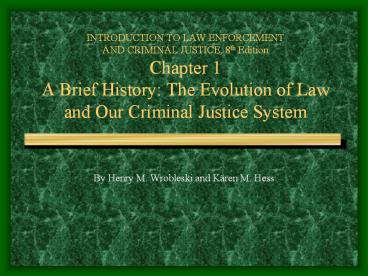INTRODUCTION TO LAW ENFORCEMENT AND CRIMINAL JUSTICE, 8th Edition Chapter 1 A Brief History: The Evolution of Law and Our Criminal Justice System - PowerPoint PPT Presentation
Title:
INTRODUCTION TO LAW ENFORCEMENT AND CRIMINAL JUSTICE, 8th Edition Chapter 1 A Brief History: The Evolution of Law and Our Criminal Justice System
Description:
INTRODUCTION TO LAW ENFORCEMENT AND CRIMINAL JUSTICE, 8th Edition Chapter 1 A Brief History: The Evolution of Law and Our Criminal Justice System – PowerPoint PPT presentation
Number of Views:271
Avg rating:3.0/5.0
Title: INTRODUCTION TO LAW ENFORCEMENT AND CRIMINAL JUSTICE, 8th Edition Chapter 1 A Brief History: The Evolution of Law and Our Criminal Justice System
1
INTRODUCTION TO LAW ENFORCEMENT AND CRIMINAL
JUSTICE, 8th EditionChapter 1A Brief History
The Evolution of Law and Our Criminal Justice
System
- By Henry M. Wrobleski and Kären M. Hess
2
What is law?
- Law refers to all the rules of conduct
established and enforced by the custom, authority
or legislation of a group, community or country. - Law implies both prescription (rule) and
enforcement by authority. - In the United States, those who enforce the laws
are not the same as those who make them.
3
When and why did law enforcement begin?
- A system of law and law enforcement began earlier
than 2000 B.C. as a means to control human
conduct and enforce societys rules. Keeping the
peace was the responsibility of the group.
4
Figure 1-1 From the Code of Hammurabi (2200 B.C.)
- If a builder builds a house for a man and
does not make its construction firm and the house
collapses and causes the death of the owner of
the housethat builder shall be put to death. If
it causes the death of a son of the ownerthey
shall put to death a son of that builder. If it
causes the death of a slave of the ownerhe
shall give the owner a slave of equal value. If
it destroys property he shall restore whatever it
destroyed and because he did not make the house
firm he shall rebuild the house which collapsed
at his own expense.
5
Peelian Reform
- Sir Robert Peel was known as the father of
modern policing - Peels principles for reform called for
- Local responsibility for law and order
- Appointed, paid civilians to assume this
responsibility and, - Standards for conduct and organization.
- Peels proposals led to the organization of the
Metropolitan police of London in 1829.
6
The principles of Peelian Reform stated
- Police must be stable, efficient and organized
militarily. - Police must be under governmental control.
- The deployment of police strength by both time
and area is essential. - The securing and training of proper persons is at
the root of efficiency. - Public security demands that every police officer
be given a number. - Police headquarters should be centrally located
and easily accessible.
(continued . . .)
7
The principles of Peelian Reform stated
- Policemen should be hired on a probationary
basis. - The duty of police is to prevent crime and
disorder. - The test of police efficiency is the absence of
crime and disorder, not the visible evidence of
police action in dealing with these problems. - The power of the police to fulfill their duties
is dependent on public approval and on their
ability to secure and maintain public respect. - The police should strive to maintain a
relationship with the public that gives reality
to the tradition that the police are the public
and the public are the police.
8
Federal Law Enforcement
- Congress created several federal law enforcement
agencies to meet demands created by the nations
changing conditions. - Among the earliest of these agencies were the
U.S. Marshals Office, the Immigration and
Naturalization Service, the Secret Service, and
the Internal Revenue Service. - The recent creation of the Department of Homeland
Security brought with it a reorganization of the
Department of Justice and the Department of the
Treasury.
9
Law Enforcement Agencies Within DHS
Department of Homeland Security
U.S. Coast Guard
Secret Service
Federal Computer Incident Response Center
Bureau of Citizenship and Immigration Services
Customs and Border Protection
Office of Inspector General
Transportation Security Administration
10
The Three Eras of Policing
- The Political Era (1840-1930)
- The Reform Era (1930-1980)
- The Community Era (1980-Present)
11
The Political Era (1840-1930)
- Police forces characterized by
- broad social service function
- a decentralized organization
- intimate relationship with community
- extensive use of foot patrol
- The spoils system
- The Pendleton Act and civil service system
- African-American officers discriminated
against, kept segregated - Women officers protective and nurturing role,
not crime-fighting
12
The Reform Era (1930-1980)
- Police forces characterized by
- authority coming from the law and professionalism
- crime control as primary function
- centralized, efficient organization
- professional remoteness from community
- emphasis on preventive motorized patrol, rapid
response to crime - Influence of August Vollmer
- Impact of Blue Ribbon Commissions
- Advances for women and minorities
- Griggs v. Duke Power Co.
- Equal Employment Opportunity Act (EEOA)
13
The Community Era (1980-Present)
- Police forces characterized by
- authority coming from community support, law and
professionalism - provision of a broad range of services, including
crime control - decentralized organization with more authority
given to patrol officers - intimate relationship with the community
- use of foot patrol and a problem-solving approach
14
Juvenile Justice System
- Doctrine of parens patriae
- Four major phases in the development of the
juvenile justice system - A Puritan emphasis
- An emphasis on providing a refuge for youths
- Development of a separate juvenile court
- Emphasis on juvenile rights
- Illinois Juvenile Court Act of 1899































